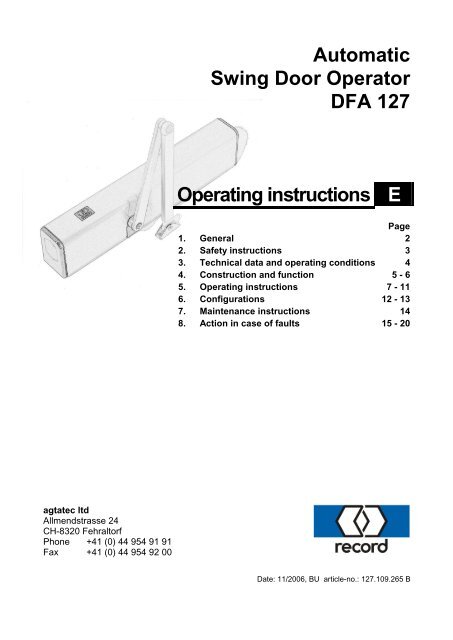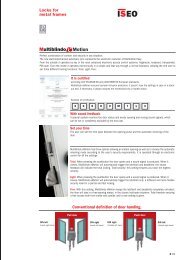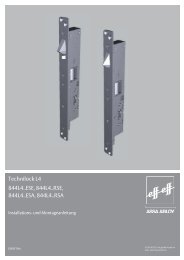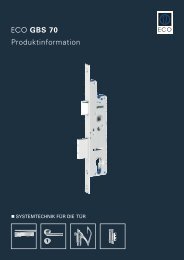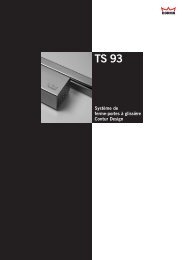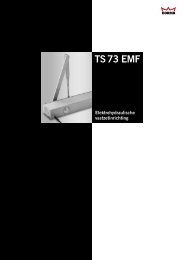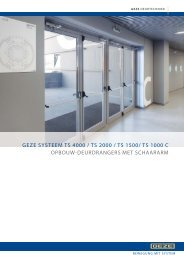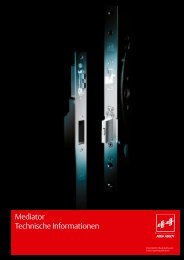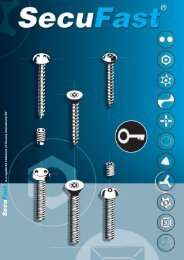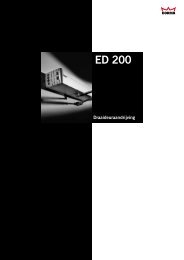Automatic Swing Door Operator DFA 127 Operating instructions E
Automatic Swing Door Operator DFA 127 Operating instructions E
Automatic Swing Door Operator DFA 127 Operating instructions E
- No tags were found...
You also want an ePaper? Increase the reach of your titles
YUMPU automatically turns print PDFs into web optimized ePapers that Google loves.
<strong>Automatic</strong><strong>Swing</strong> <strong>Door</strong> <strong>Operator</strong><strong>DFA</strong> <strong>127</strong><strong>Operating</strong> <strong>instructions</strong> EPage1. General 22. Safety <strong>instructions</strong> 33. Technical data and operating conditions 44. Construction and function 5 - 65. <strong>Operating</strong> <strong>instructions</strong> 7 - 116. Configurations 12 - 137. Maintenance <strong>instructions</strong> 148. Action in case of faults 15 - 20agtatec ltdAllmendstrasse 24CH-8320 FehraltorfPhone +41 (0) 44 954 91 91Fax +41 (0) 44 954 92 00Date: 11/2006, BU article-no.: <strong>127</strong>.109.265 B
1 GeneralThese operating <strong>instructions</strong> are intended for the record <strong>DFA</strong> <strong>127</strong> FP EU orrecord <strong>DFA</strong> <strong>127</strong> FP GG EU automatic swing door operator (herein after referred toas <strong>DFA</strong> <strong>127</strong>). The operator is the person responsible for the technical maintenanceof this door system.These <strong>instructions</strong> describe the use of the record <strong>DFA</strong> <strong>127</strong> swing door operator.They form the basis for satisfactory functioning.These operating <strong>instructions</strong> should be read by the door operator before commissioningand the safety <strong>instructions</strong> observed!It is recommended to keep these operating <strong>instructions</strong> close to the automatic slidingdoor.Product designation:Product name:Serial number:<strong>Automatic</strong> swing door operatorrecord <strong>DFA</strong> <strong>127</strong> FP EU orrecord <strong>DFA</strong> <strong>127</strong> FP GG EU(please complete when installing)Page 2 of 20 Rev. 11/2006 <strong>Operating</strong> <strong>instructions</strong> <strong>DFA</strong> <strong>127</strong> Full Power
2 Safety <strong>instructions</strong>The record <strong>DFA</strong> <strong>127</strong> swing door operator has been constructed in accordance withthe latest state of the art and the recognised technical safety regulations, includinglimiting of forces and speeds. Nevertheless, danger can arise for the user if notused as intended.Installation, maintenance and repairs to the record <strong>DFA</strong> <strong>127</strong> must onlybe performed by qualified and authorized personnel (technicians).2.1 Use as intendedThe <strong>DFA</strong> <strong>127</strong> swing door operator is constructed exclusively for normal servicewith swing doors in dry rooms and must be installed within or inside buildings.A different application or use extending beyond this purpose is not considered usefor the intended purpose. The manufacturer declines all responsibility for resultingdamage; the operator alone shall bear the associated risk.Use for the intended purpose also includes observation of the operating conditionsspecified by the manufacturer, including use and adjustment of the correct type ofarms, in addition to regular maintenance and repair.Unauthorised modifications to the automatic door operator exclude any liability ofthe manufacturer for resulting damage.2.2 General safety and accident prevention regulationsIn general no safety devices (sensors) may be dismantled or put out ofservice.During the learning cycle (which must only be performed by trained personnel)the safety devices (sensors) are switched off! It must be ensured,therefore, before initiating the learning cycle that no persons orobjects are situated in the danger zone of the moving door leaves duringthe operation in order to avoid injury or damage!No objects must be placed in the opening zone / path of the swing doorto avoid crushing and shearing points!The safeguard for crushing and shearing strains at the side edge mustbe provided by the manufacturer..<strong>Operating</strong> <strong>instructions</strong> <strong>DFA</strong> <strong>127</strong> Full Power Rev. B 11/2006 Page 3 of 20
3 Technical DataDimensions: <strong>Operator</strong> 600 x 85 x 124 mm (w x h x d)<strong>Operating</strong> voltage: 230V∼Power consumption: Standby 13 W, rated power 67 WMax. torque:50 NmOpening angle: Adjustable from 70° to 115°Time delay:Adjustable from 0 to 20 secondsOpening speed:Adjustable from 3 to 20 secondsClosing speed:Adjustable from 5 to 20 secondsNoise emission-18 dBEnvironment conditionsTemperature range: -15 to + 50°CHumidity range:Up to 85% relative humidity, non bedewing3.1 Permissible door leaf weights and door widthsThe curves are calculated using to the following formula:J = 1/3 · m · b 2Standard arms : J max. 65 kgm 2 Key : J = mass moment of inertia [kgm 2 ]Slide arms : J max. 65 kgm 2 m = door leaf weight [kg]b = door leaf width [m]Page 4 of 20 Rev. B 11/2006 <strong>Operating</strong> <strong>instructions</strong> <strong>DFA</strong> <strong>127</strong> Full Power
4 Construction and Function4.1 Construction1 2 34 5 6 7 1513 12 14 11 10 9 8 16Key to illustration:1 Mains connection terminals 9* Slide switch S1 (rotating direction)switch2 Fine-wire fuse 10* Multifunctional switch MF on STG3 Power supply NET 11 Closing spring4 Drive unit ATM 12 Vision panel adjust. spring tension5 Control unit STG 13* Adjusting screw for spring tension6 Connection terminals control unit 14 Connectors for arms (both sides)7 Motor print MOT 15 Standard switch BDI8 ATE drive unit terminals 16 Status signal and Reset button* Do not change any settings or adjustments! These operations are reservedexclusively for trained and authorized persons.4.2 ComponentsThe record <strong>DFA</strong> <strong>127</strong> swing door operator forms part of an electromechanical swingdoor system and comprises the following main components:Control unit STG:Driving unit ATE:Power supply NET:Control unit BDE:Intelligent, learning, microprocessor-controlled controlsystem.Low maintenance DC geared motor with electronic pathmeasurement and integral thermostatic protectiveswitch, gear box with adjustable spring tension.Compact 230 V power supply with integral input filterand over-voltage protection.As required with convenient, simple mechanical controlunit and / or a programmable electronic BDE-D.<strong>Operating</strong> <strong>instructions</strong> <strong>DFA</strong> <strong>127</strong> Full Power Rev. B 11/2006 Page 5 of 20
Construction and FunctionArm types:Power transmission to the door leaf by use of standardarm pushing or sliding arm pulling/pushing.Locking VRR (optional): It is possible to connect an electrical door opener(24VDC) to the operator.Sensing units:Aesthetic actuating and self-monitoring safety elementswith adjustable sensitivity ensure optimum, smooth andreliable operation of the door system.4.3 Functional descriptionIn the standard "<strong>Automatic</strong>" mode of operation the door system opens by the responseof an actuating device (e.g. radar unit) to persons or objects approaching.The door closes after the door hold-open time, provided no further opening pulseis received.In the "Lock" mode of operation, the door is only opened by actuation of an optionalkey-operated contact (SSK). The door closes after the SSK door hold-opentime, provided no further opening pulse is received.An obstacle to the swing door leave during Closing leads to an immediate reopening(reverse). The obstacle position is recorded in the door operator and thisposition is approached slowly when next closing. An obstacle to the swing doorleaf when Opening results in an immediate stop.Page 6 of 20 Rev. B 11/2006 <strong>Operating</strong> <strong>instructions</strong> <strong>DFA</strong> <strong>127</strong> Full Power
5 <strong>Operating</strong> <strong>instructions</strong>5.1 Mech. control elements and indication1 2 31 Mechanic BDI with 3 positions (control toggle switch)2 Reset button3 Status signalMechanical BDI (control toggle switch)The following operational modes can be set up with the 3-position toggle switch onthe side cover:Manual operationIn this operation mode, the <strong>DFA</strong> works as a normal door-closer. It can easily beopened manually, and then closes automatically. The connected actuating elementsare inactivated.<strong>Automatic</strong>The door opens and closes automatically, either by activation of an actuating elementor by pushing with activated touch control.Continuously openThe door opens and remains in the open position. If an obstacle is encounteredwhile opening, the <strong>DFA</strong> will attempt during the next few seconds to get the doorinto the set open position. If the obstacle is still present, the current position will beaccepted as the continuously open position.<strong>Operating</strong> <strong>instructions</strong> <strong>DFA</strong> <strong>127</strong> Full Power Rev. B 11/2006 Page 7 of 20
<strong>Operating</strong> <strong>instructions</strong>The mechanical BDI is by factory default always connected and active on a <strong>DFA</strong><strong>127</strong>. If an additional electronic BDE-D is connected, the operating mode is set by adefined priority structure from the BDE with the highest priority.The priority and the code shown in the following table apply to the operating mode,whereby BDE2 (S2) and BDE1 (S1) represent the two input terminals of the controlunit ( J7/1 + J7/2, p.c.b. BDE-M) for the mechanical BDE:(L = interruption or 0V, H = +24V)Mechanical BDI (toggle switch)Electronic BDE-DBDE2 (S2) BDE1 (S1) Function Priority(1=highest)locked 1one-way 2L H continuously open 3H L manual 4L L automatic 5The BDE-D indicates the current operating mode.If an operating mode is set on the BDE-D, which has no current priority, the statusmessage 62 is displayed.Reset buttonAfter pushing for approx. 5 sec. a new start of the control is performed (softwarereset). After the reset the LED lights up permanently.Status signal- Remains off if no fault is present.- Will blink if a fault is present (see status and fault signals / chapter 8)- Does light up permanently during a reset.Page 8 of 20 Rev. B 11/2006 <strong>Operating</strong> <strong>instructions</strong> <strong>DFA</strong> <strong>127</strong> Full Power
<strong>Operating</strong> <strong>instructions</strong>5.2 Auxiliary controls on the control unit STG <strong>127</strong>General:The CONTROL UNIT STG <strong>127</strong> operates with active HIGH level, i.e. a +24 V levelmust be applied to activate a function. Safety inputs are activated during interruptions.The signal ground (0V) is connected to protective earth.Jumpers:J14: Master / Slavejumper at position M1 for master (factory setting)jumper at position S1 for slaveJ13: CAN line terminationLED’s:LD1: (red)control LED for push-button operation (S1)LD2: (green) +35VOff for power failureLD3: (green) +24VLights if +24V present.Caution: in the event of a power failure processor reset takesplace 1 second after this LED extinguishes.Push button S1This is a multifunctional switch on controller (MF).The use of this switch is reserved exclusively for trained and authorizedpersons.Top view of the control unit STG:<strong>Operating</strong> <strong>instructions</strong> <strong>DFA</strong> <strong>127</strong> Full Power Rev. B 11/2006 Page 9 of 20
<strong>Operating</strong> <strong>instructions</strong>5.3 Functions of electronic controller BDE-D (optional)The electronic controller BDE-D is an easily operatedinput and output device for the controland adjustment of record door operators.Logically arranged push buttons allow an intuitiveoperation and navigation through the operatorspecificmenu. The LCD with backlight showsdata and information about the door status withsymbols and text messages.Additional information can be taken from themanual of the BDE-D (No. 903 109 271).5.4 Operation modes<strong>Automatic</strong>Normal functionTable to signals (X marks a release reaction)CLOSED OPENING OPEN CLOSINGAKI x x x xAKA x x x xSSK x x x xSIO x x xSIS x xTIPP xOne-way trafficIn one-way traffic mode people cannot enter the room from the outside but theycan leave it from the inside.Table to signals (X marks a release reaction)CLOSED OPENING OPEN CLOSINGAKI x x x xAKA* x x xSSK x x x xSIO x x xSIS x xTIPP* AKA is active as safety device while closingPage 10 of 20 Rev. B 11/2006 <strong>Operating</strong> <strong>instructions</strong> <strong>DFA</strong> <strong>127</strong> Full Power
<strong>Operating</strong> <strong>instructions</strong>Manual operationThe door can be opened and closed by hand.Open continuouslyThe door is opened and stays open.LockedIn the operation mode Locked the locking is activated.Table to signals (X marks a release reaction)CLOSED OPENING OPEN CLOSINGAKI x x xAKA x x xSSK x x x xSIO x x xSIS x xTIPPResetAfter pushing on the buttondisplay is:for approx. 5sec. this status message on theNoReset <strong>Operator</strong>?YesPushing again on thebutton resets the operator.<strong>Operating</strong> <strong>instructions</strong> <strong>DFA</strong> <strong>127</strong> Full Power Rev. B 11/2006 Page 11 of 20
6 Configurations6.1 Parameter OverviewPage 12 of 20 Rev. B 11/2006 <strong>Operating</strong> <strong>instructions</strong> <strong>DFA</strong> <strong>127</strong> Full Power
ConfigurationsConfigurations of the <strong>DFA</strong> <strong>127</strong> can only be made with the electronic BDE-D. If atoggle switch is connected, a BDE-D must be connected briefly for the configuration.Further information for parameter changes can be taken from the user manual ofthe BDE-D (no. 903 109 271).Please always leave the configuration review sheet in the drive!6.2 Parameter descriptionParameter SettingrangeDRIVING CYCLEClosing speed 0 - 40(5 – 20 s)Opening speed 0 - 40(3 - 20 s)TIME DELAYOPENTime delay open 0 - 40(0 - 60 s)Time delay SSK 0 – 40(0 - 60 s)FactorydefaultDescription18 Slider control with 40 steps36 Slider control with 40 steps2 Effective with AKA, AKI and push toactuate0 - 20: Steps of 1 s21 - 40: Steps of 2 s4 Effective with SSK0 - 20: Steps of 1 s21 - 40: Steps of 2 sDRIVEOpening angle 0 - 40 35 The opening angle is estimated duringthe calibration run and is equivalentto the value of 40.6.3 Different factory defaults for door types Low EnergyParameterFactorydefaultParameterFactorydefaultDRIVING CYCLEClosing speed 10 Opening speed 20<strong>Operating</strong> <strong>instructions</strong> <strong>DFA</strong> <strong>127</strong> Full Power Rev. B 11/2006 Page 13 of 20
7 Maintenance <strong>instructions</strong>7.1 GeneralThe record <strong>DFA</strong> <strong>127</strong> swing door operator is a product of the latest technology. Ithas been carefully made and only leaves the factory following thorough testing.<strong>Automatic</strong> swing doors should be operated and maintained to ensure safety at alltimes.7.2 CareThe entire swing door system can be cleaned with a damp cloth and commerciallyavailable cleaning agents. The cleaning agent must be harmonised to the surfacewhich has to be cleaned.It is recommended to select the "Continuously open" or "Locked" mode of operationfor this purpose, so that the door does not continually open and close unnecessarily.7.3 Maintenance, periodic inspectionIt is recommended to have a technical safety test with servicing performed by aspecialist before first commissioning and as required, but at least twice a year.Regular testing and servicing by our fully trained personnel therefore offers the bestguarantee for a long service life and satisfactory operation. We therefore recommendthe signing of a maintenance agreement. Our service department will bepleased to submit a proposal.If nevertheless a fault should occur, which you cannot eliminate (see section 8) ourservice organisation or the maintenance personnel of our agents are available.7.4 Service centresIn Switzerland: Phone +41 (0) 44 954 92 92 / Fax +41 (0) 44 954 92 00Alternative service centre: _____________________________________________Page 14 of 20 Rev. B 11/2006 <strong>Operating</strong> <strong>instructions</strong> <strong>DFA</strong> <strong>127</strong> Full Power
8 Action in case of faults8.1 Fault indicationVarious indications are given for an irregularity or fault depending on the controlunit connected BDE-E or BDE-M.When using a mechanical BDE (control toggle switch)With the mechanical control unit it is not possible to display a detailed status signal.If a fault occurs (will be shown by the status signal on the side cover), pleaseproceed according to section 8.2.When using an electronic BDE-DGeneralAny current operational faults in the drive system will be displayed in the Standardscreen. If several faults are active, they will be numbered: e.g. Fault 1/2In case of an irregularity the display changes automatically from mode of operationlevel to error display. Every 2 seconds the backlight changes between normal/invers. Several errors can be displayed (e.g. 1/2 means: error no. 1 of total 2 errors).After 10 seconds the telephone number of the responsible service centre is indicatedalternating to the fault indication. The failure indication and the phone numberchange every 5 seconds, while the inverse flashing is remaining. The describedsequence applies to all failures. However, previously the phone numbermust have been given by an authorised specialised person.Information about the drive system, such as the software version, can be read outby pressing the key.After pressing this key once again, the phone number of the responsible servicecentre and the last appeared fault indication is displayed in the screen. If the faultmessage consists of several lines the first line will be displayed only.Status signals with a "W" are warnings. For these the fault relay contact output isnot connected. Elimination of the irregularity leading to the status signal is performedaccording to section 8.2A status can usually be deleted by pressing the key for 5 s (= Reset). This producesa new start in the control unit.If, however, the cause of the fault has not been eliminated, the status message willappear again if the fault occurs again.<strong>Operating</strong> <strong>instructions</strong> <strong>DFA</strong> <strong>127</strong> Full Power Rev. B 11/2006 Page 15 of 20
Action in case of faults8.2 Error eliminationThe majority of faults can be eliminated by consulting the following table. If thefault cannot be eliminated even after working through the table, please contact theservice centre. Please also contact the service centre directly when no recommendedaction is specified in the table.StatusSymptom, fault,door behaviour03 <strong>Door</strong> remains open05 <strong>Door</strong> remains open06 <strong>Door</strong> does not unlock Unlocking faultCauseActuating device inside active longer than60 sActuating device outside active longer than60 sAction(consult service if norecommend-action)23 Control unit SLAVE defective Reset by service fitter25 MASTER / SLAVE connection interrupted Reset by service fitter31 <strong>Door</strong> stops EMERGENCY STOP button operatedRelease EMERGENCYSTOP button37 <strong>Door</strong> stops Faulty motor current<strong>Door</strong> changes to manualWait until motor has38Excess temperature motorcontrolcooledPeripheral devices take39Overload on +24 V supplyReset by service fittertoo much power41 <strong>Door</strong> stops Motor 1 thermal sensor defective Reset by service fitter43 <strong>Door</strong> stops Incremental transmitter defective Reset by service fitterMinimum hold-open timeWait until motor has45Motor current time product too largeincreased to 20 secs.cooled46 <strong>Door</strong> stops Control unit defective Reset by service fitter47<strong>Door</strong> remains closedSIO sensor longer activ than 60 sec.Remove obstacle fromsurveillance range ofsensor50 <strong>Door</strong> stops Control unit defective Reset by service fitter52 No valid drive parameter Initiate calibration run53 <strong>Door</strong> stops Interruption motor Reset by service fitter54 W59<strong>Door</strong> jolts possibly whileopening<strong>Door</strong> stopsCalibration runSIS sensor longer activ than 60 sec.Initiate 1 opening cycleRemove obstacle fromsurveillance range ofsensor60 <strong>Door</strong> stops Parameter memory defective Reset by service fitter61 <strong>Door</strong> remains open62 WHigher-order mode ofoperation presentKey operated contact active longer than 60sControl unit BDE has no priorityRelease key contactCancel higher-ordermode of operationPage 16 of 20 Rev. B 11/2006 <strong>Operating</strong> <strong>instructions</strong> <strong>DFA</strong> <strong>127</strong> Full Power
Status and fault signals8.3 Detail description of status indicationsGeneralA status can usually be deleted by pressing the key for 5 s (= Reset). Thisproduces a new start in the control unit.If, however, the cause of the fault has not been eliminated, the status messagewill appear again if the fault occurs again.The following list contains the causes of faults in decreasing possibility. The faultat the bottom of the list has the smallest probability to occur in the control unitSTG.Status 3:Status 5:Status 6:Status 9:Status 11:Status 23:Status 25:Status 31:Status 37:Status 38:AKI sensor active longer than 60 s<strong>Automatic</strong>ally reset if everything is in order, or by service fitterAKA sensor active longer than 60 s<strong>Automatic</strong>ally reset if everything is in order, or by service fitterUnlocking errorBolt possibly jammedReset by service fitter“Opening” unsuccessful (after 4 collisions)Check the interlock / remove obstacleReset through service fitterFaulty motor currentPossibly faulty wiring in prefabricated cablesReplacement by service fitterSlave control unit defectiveReplacement by service fitterSlave connection (CAN) to Master interruptedClear by service fitterEMERGENCY STOP operated. Motor relay de-energisesReset by resetting the EMERGENCY STOP buttonMotor currentSTG or ATE defectiveReset by service fitterOverheat motorManual control effective<strong>Door</strong> leaves possibly too heavy, or too much frictionReset by motor cooling down or by service fitter<strong>Operating</strong> <strong>instructions</strong> <strong>DFA</strong> <strong>127</strong> Full Power Rev. B 11/2006 Page 17 of 20
Status and fault signalsStatus 39:Status 41:Status 43:Status 45:Status 46:Status 47:Status 50:Status 51:Status 52:Status 53:Status 54:Overload on + 24 V supplyToo many external units possibly connectedReset by service fitterMotor – temperature sensor defectiveMotor possibly not connectedSensor in motor possibly defective or cable break in sensor leadReset by service fitterIncremental encoder faultInput cable possibly not connected or cable break in the leadMotor possibly blockedReset by service fitterMotor current – time product to highMotor relay de-energisesManual control effective<strong>Automatic</strong> reset by motor cooling or by service fitterControl unit STG defectiveIncludes the following individual faults:EPROM, RAM, Watchdog, Imax, ImaxT, difference on SHE-EXTReset by service fitterSIO sensor active longer than 60 s<strong>Automatic</strong>ally reset if in order, or by service fitterCPU2 is defectiveReset by service fitterSoftware versionSoftware version of Master and Slave do not correspond to eachother. Software update by service fitterNo running parameterStart calibration runInterruption motorPossibly no connection to motorReset by service fitterCalibration runReset automaticallyStatus 59:SIS sensor active longer than 60 s<strong>Automatic</strong>ally reset if in order, or by service fitterPage 18 of 20 Rev. B 11/2006 <strong>Operating</strong> <strong>instructions</strong> <strong>DFA</strong> <strong>127</strong> Full Power
Status and fault signalsStatus 60:Status 61:Status 62:Status 72:Status 88:Status 89:Status 90:Status 91:Status 92:Parameter memory (EEPROM) defectiveChange control unitReset by service fitterSSK active longer than 60 s<strong>Automatic</strong>ally reset if in order, or by service fitterBDE has no priorityBecause a higher-level signal is present<strong>Automatic</strong>ally reset on release of BDE-buttonSlave connectionMaster has no connection to Slave operatorReset by service fitterDifference parameterThe common parameters of M/S operators do not correspond toeach other.Reset by service fitterMaster connectionSlave has no connection to master operatorReset by service fitterRailbeam active > 60 sec.<strong>Automatic</strong>ally reset if everything is in order, or by service fitterBodyguard active > 60 sec.<strong>Automatic</strong>ally reset if everything is in order, or by service fitterSTG relay defectiveReplacement by service fitterStatus 93: Overvoltage 24 V (from 27V)Status 94:Status 95:Status 96:Status 99:Status 105:Spring calibration<strong>Automatic</strong> resetError in sense of rotationEEPROM void<strong>Operator</strong> rotatesThe grease in the gear will be dispersed.<strong>Automatic</strong> resetTest brake<strong>Automatic</strong> reset<strong>Operating</strong> <strong>instructions</strong> <strong>DFA</strong> <strong>127</strong> Full Power Rev. B 11/2006 Page 19 of 20
Status and fault signalsStatus 106:Status 107:Status 108:Status 109:Brake defectiveReset or reset by service fitterSIS defectiveA safety sensor (with test input) in closing direction is defective.Reset by service fitterSIO defectiveA safety sensor (with test input) in opening direction is defective.Reset by service fitterFactory settingsStatus 110:No motorNo motor detection during initialisation (motor temperature sensor).Check motor temperature sensor.Reset or reset by service fitterA status number with a "W" is a warning !!Page 20 of 20 Rev. B 11/2006 <strong>Operating</strong> <strong>instructions</strong> <strong>DFA</strong> <strong>127</strong> Full Power


